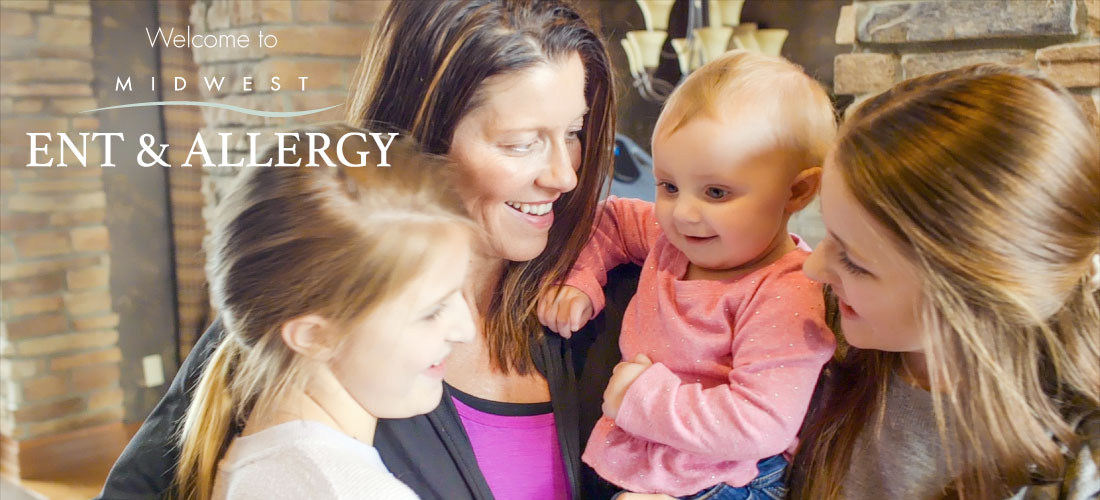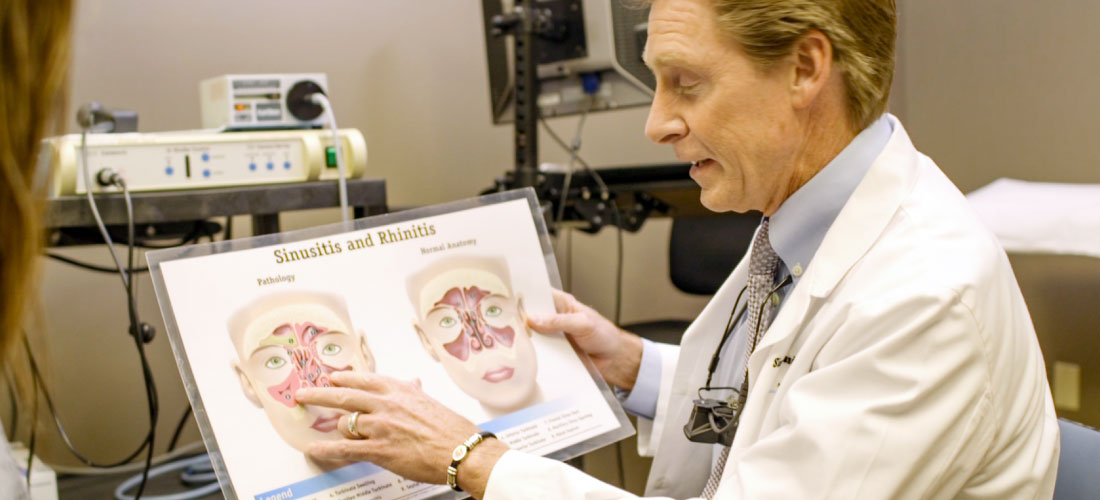Hearing loss doesn’t just mean someone needs to turn up the TV or ask “Can you repeat that?” It has also been linked to an increased risk of dementia.
The doctors at Midwest ENT & Allergy know parents have concerns when their child seems to be suffering. Dr. Todd provides answers to six common questions parents have when it comes to testing kids for allergies
Obstructive Sleep Apnea
Obstructive sleep apnea refers to a blockage of the upper airway during sleep that causes one to stop breathing periodically. This may leave people tired after a full night's rest. Significant factors in sleep apnea will be analyzed during this screening, including snoring, fatigue, history, neck circumference, etc.
The consequences of untreated sleep apnea are as follows:
- Increased risk of death
- Risk of high blood pressure
- Risk of coronary artery disease
- Risk of stroke
- Impairment of memory, cognition
- Risk of heart failure
- Risk of diabetes mellitus
Treatment Options:
Treatment plans vary based on each individual patient.
- Plan A is always simple things like weight loss, exercise, sleep positioning, nasal steroid spray, breathe-rite strips, and even dental appliances.
- Plan B is usually a type of CPAP. CPAP stands for continuous positive airway pressure. It is a device that the patient wears (like a nose or face mask) that keeps the tissues from collapsing by continuously blowing positive air pressure into the nose.
- Plan C is surgery. This can vary from nasal airway surgery all the way to tonsil and palatal surgery and even involve the base of the tongue.
Insomnia
Insomnia is a very common sleep disorder defined by nighttime and daytime symptoms. Nighttime symptoms include persistent problems falling and/or staying asleep and non-restorative sleep. Daytime symptoms of insomnia can include decreased sense of well-being, decline in functioning such as concentration and memory, fatigue, and persistent concerns and worries about sleep. Insomnia may be a brief response to stress, but in some people it can persist for many years.
About 75 percent of people with insomnia can identify a definite cause of their insomnia. One of the most common causes is stress related to family or work situations. Poor sleep is a common reaction to stress, but there are significant individual differences in how people react to stress. These differences play a role in the development of insomnia. Factors such as sleep apnea, chronic pain, breathing difficulties, thyroid function, depression, acid reflux, restless legs syndrome and urinary frequency can all influence insomnia. Medications can also contribute to poor sleep. These medications include caffeine, nicotine, stimulants, asthma medications, allergy and cold medications, steroids and beta blockers. Alcohol or other sedatives wear off in the middle of the night and can cause disrupted sleep.
Environmental factors can also disrupt sleep. Worrying about getting enough sleep is counterproductive and can end up making it even more difficult to fall asleep. Trying too hard to get to sleep produces a similar outcome. Watching TV, reading, room temperature and lighting can all have a negative impact on our sleep.
Your provider will obtain a sleep history and provide you with different questionnaires to help diagnose your insomnia and rule out other sleep disorders. Tools utilized may include a Sleep Diary, an Epworth Sleepiness Scale test, an Insomnia Severity Index, or a Polysomnogram Sleep Study. The Polysomnogram includes an overnight stay in a certified sleep laboratory. It is not necessary for a diagnosis of insomnia, but may be recommended in certain patients with a suspicion that they have another contributing sleep disorder. Sleep disorders can include sleep apnea or periodic limb movements.
Sleep
 Nearly one in ten adults in the United States suffers from sleep issues. Insomnia is a sleep disorder defined by both night-time and day-time symptoms. These symptoms include problems falling asleep and staying asleep, non-restorative sleep, a decreased sense of well being, fatigue, decline in concentration and memory, etc. Another sleep issue – called sleep apnea – blocks the upper airway during sleep and causes breathing issues and snoring that leave you tired after a full night's rest.
Nearly one in ten adults in the United States suffers from sleep issues. Insomnia is a sleep disorder defined by both night-time and day-time symptoms. These symptoms include problems falling asleep and staying asleep, non-restorative sleep, a decreased sense of well being, fatigue, decline in concentration and memory, etc. Another sleep issue – called sleep apnea – blocks the upper airway during sleep and causes breathing issues and snoring that leave you tired after a full night's rest.
The Sleep Center of the Midwest will help determine which factors are causing insomnia or sleep apnea. Our on-site sleep lab allows patients the convenience of getting all their testing and treatment in one location. The physicians at Midwest Ear, Nose & Throat will conduct a sleep study, review the results with the patient and consider treatment options.
Call for your appointment today and discover better sleep for you or your loved one.
Pediatrics
Pediatrics
At Midwest Ear, Nose & Throat we love kids and take the best care of them! We can diagnose and treat reflux, allergies, sinusitis, tonsillitis, otitis media and sleep apnea, with a common-sense approach using a single doctor. Our Sinus and Allergy division allows us to treat allergies with medicine, immunotherapy or surgery. Because we are trained in surgery of the ear, nose, sinuses and throat, we are the best choice for pediatric patients. We specialize in the following Pediatric services.
- Ear tubes
- Tonsils and adenoids
- Hearing issues
- Ear pain
- Allergies
- Sinusitis
- Tongue and mouth problems
- Obstructive sleep apnea
- Reflux (GERD)
- Speech therarpy
Pediatric Allergies
Infants and toddlers have a much more permeable GI tract, and therefore are very susceptible to food allergies. Food allergies and sensitivities may cause a wide range of adverse reactions to the skin, respiratory system, stomach and other physiological functions of the body.
Food allergies can result in vomiting, diarrhea, bloating and colic in children. They can also result in skin symptoms such as atopic dermatitis, or upper respiratory tract symptoms such as nasal congestion, ear and sinus infections. In children, they lead to many sleepless nights for both the child and her parents. Eosinophilic esophagitis is a new and disturbing condition caused by allergies affecting the gastrointestinal tract.
Although there are always exceptions, it is rare in children to have a lot of inhalant allergies. The younger the child, the more likely ingestants such as milk are the allergic culprits. As they get older, inhalants become more prominent, and severely allergic kids seem more likely to develop reactive airways or asthma. Most would agree that early and aggressive treatment is beneficial in preventing this progression.
An infant should have at least a six month delay in consuming solid foods. They should be between 6 and 12 months old before consuming cow’s milk and dairy products, be between 12-24 months old before being offered eggs, and be between 24-28 months of age before peanuts, tree nuts and seafood is introduced. If the infant continues to struggle, they should be tested for other ingestant allergies such as egg and soy. Based on what we find, we can help with avoidance, pharmicotherapy or immunotherapy (such as allergy drops). Pleasa see our allergy section.
Treatment of food allergies
Treatment is mainly through dietary manipulation. Casein and whey are the primary antigenic proteins in cow’s milk, and dairy is the biggest culprit of pediatric allergies. In children who are not nursing, we often will try a hypoallergenic formula. Goat’s milk is a good alternative for some. Soy milk is excellent if they are not soy-allergic, and rice milk is also a good option.
In the case of emergency treatment, epinephrine is the drug of choice for an emergency response to reactions. Self-administered epinephrine is readily available, and patients can be trained to self-administer this medication. Antihistamines can be a secondary therapy. It is also good to have an emergency plan in writing, available to schools, spouses, caregivers, mature siblings and friends. We also recommend an emergency identification bracelet.
If the history and testing confirms a cyclic food allergy, you will be asked to abstain from feeding your child this food for a period of 3-6 months. After this time you can slowly reintroduce the food, not to be eaten more frequently than every four days (once or twice a week).
Pediatric Sinus and Ear Infections
Although small, the maxillary (behind the cheek) and ethmoid (between the eyes) sinuses are present at birth. The small anatomy combined with the enlarged tonsils and adenoids make for overall tight spaces and may predispose them to blockage and subsequent infections. Allergic rhinitis, either from foods or inhalants, can lead to further congestion, worsening the problem. Once the sinus openings are blocked, the secretions just sit there and can become infected with bacteria.
The middle ear itself is essentially a sinus – that is, an air containing space connected to the nose. Thus, when a child has rhinosinusitis they almost always get ear infections. These infections are especially common in early childhood. They are even more common when children suffer from allergies as well. Allergic inflammation can cause swelling of the adenoids in the nose and around the opening of the Eustachian tube (ear canal). This swelling has the potential to interfere with drainage of the middle ear. When bacterial sinusitis exists, infection can often travel up the Eustachian tube to infect the middle ear.
Tonsils and adenoids become more inflamed with allergies and infections. They not only tend to obstruct the upper airways but also have lots of crevices for viruses, bacteria and fungus to hide. Removal of tonsils and adenoids have repeatedly been shown to reduce the frequency and severity of pediatric upper respiratory infections, including rhinosinusitis. In addition, airway obstruction such as pediatric obstructive sleep apnea and upper airway resistance syndrome are most often cured by tonsillectomy and adenoidectomy.
There is really only one airway, from the tip of the nose to the base of the lungs. This “single airway theory” is even more evident in children. When they are sick they will have a stuffy nose with purulent rhinorhea, pus in the sinuses, fluid behind the ears, pharyngitis and cough.
You can reduce the risk of sinus infections for your child by reducing exposure to known allergens and pollutants such as tobacco smoke, and treating stomach acid reflux disease. Allergic rhinitis can cause enough inflammation to obstruct the openings to the sinuses. Consequently, a bacterial sinus infection occurs. The disease is similar for children and adults. Children may or may not complain of pain. However, in acute sinusitis, they will often have pain and typically have fever and a purulent nasal discharge. In chronic sinusitis, pain and fever are not evident. Some children may have mood or behavior changes. Most will have a runny nose and nasal congestion, even to the point where they must mouth-breathe. The infected sinus drains around the Eustachian tube, and therefore many of the children will also have a middle ear infection.
The following symptoms may indicate a sinus infection in a child:
- a cold lasting more than 10 to 14 days, sometimes with a low-grade fever
- thick yellow-green nasal drainage
- post-nasal drip, sometimes leading to or exhibited as sore throat, cough, bad breath, nausea and/or vomiting
- headache, usually in children age six or older
- irritability or fatigue
- swelling around the eyes
Young children have immature immune systems and are more prone to infections of the nose, sinus and ears, especially in the first several years of life. These are most frequently caused by viral infections (colds), and they may be aggravated by allergies. However, when your child remains ill beyond the usual week to 10 days, a serious sinus infection is likely.
If your child suffers from one or more symptoms of sinusitis for at least twelve weeks, he or she may have chronic sinusitis. Chronic sinusitis, including recurrent episodes of acute sinusitis more than 4-6 times a year, is an indication that you should seek consultation with an ear, nose and throat (ENT) specialist.
Pediatric Hearing Issues
Approximately 2 – 4 of every 1,000 children in the United States are born deaf or hard-of-hearing, making hearing loss the most common birth disorder. More than 3 million American children have a hearing loss, and an estimated 1.3 million are under age 3.
Many studies have shown that early diagnosis of hearing loss is crucial to the development of speech, language, cognitive and psychosocial abilities. Parents and grandparents are usually the first to discover hearing loss in a baby, because they spend the most time with them.
Treatment is most successful if hearing loss is identified early, preferably within the first month of life. Still, one in every four children born with serious hearing loss does not receive a diagnosis until age three or older. If at any time you suspect your baby has a hearing loss, discuss it with your doctor. He or she may recommend evaluation by an ear, nose and throat (ENT) specialist, which you can find at our clinic. The following questions can be addressed with your ear, nose and throat doctor:













